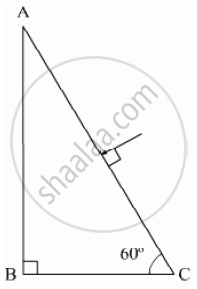Advertisements
Advertisements
Question
If light passes near a massive object, the gravitational interaction causes a bending of the ray. This can be thought of as happening due to a change in the effective refractive index of the medium given by n(r) = 1 + 2 GM/rc2 where r is the distance of the point of consideration from the centre of the mass of the massive body, G is the universal gravitational constant, M the mass of the body and c the speed of light in vacuum. Considering a spherical object find the deviation of the ray from the original path as it grazes the object.
Solution
Let us consider two spherical surfaces of radius r and r + dr. Let the light be incident at an angle θ at the surface at r and leave r + dr at an angle θ + dθ. Then from snell's law,
`n(r) sin θ = n(r + dr) sin(θ + dθ) = (n(r) + ((dn)/(dr)) dr) (sin θ * cos dθ + cos θ * sin dθ)`
⇒ `n(r) sin θ = (n(r) + ((dn)/(dr)) dr) (sin θ + cos θ * dθ)`
For small angle, sin dθ ≈ dθ and cos dθ ≈ 1
Ignoring the product of differentials
⇒ `n(r) sin θ = n(r) * sin θ + ((dn)/(dr)) dr * sin θ + n(r) * cos θ * dθ`
or We have, `- (dn)/(dr) tan θ = n(r) (dθ)/(dr)`
`(2 GM)/(r^2c^2) tan θ = (1 + (2 GM)/(rc^2)) (dθ)/(dr) ≈ (dθ)/(dr)`
`int_0^(θ_0) dθ = (2 GM)/c^2 int_(-oo)^(oo) (tan θ dr)/r^2`
Now, `r^2 = x^2 + R^2` and tan θ = `R/x`
`2rdr = 2xdx`
Now substitution for integrals, we have
`int_0^(θ_0) dθ = (2 GM)/c^2 int_(-oo)^(oo) R/x (xdx)/(x^2 + R^2)^(3/2)`
Put `x = R tan phi`
`dx = R sec^2 phi d phi`
∴ θ0 = `(2 GMR)/c^2 int_((- pi)/2)^(pi/2) (R sec^2 phi d phi)/(R^3 sec^3 phi)`
θ0 = `(2 GM)/(Rc^2) int_((- pi)/2)^(pi/2) cos phi d phi = (4 GM)/(Rc^2)`
⇒ θ0 = `(4 GM)/(Rc^2)`. This is the required proof.
APPEARS IN
RELATED QUESTIONS
Derive Snell’s law on the basis of Huygen’s wave theory when the light is travelling from a denser to a rarer medium.
Calculate the speed of light in a medium whose critical angle is 45°. Does critical angle for a given pair of media depend on the wavelength of incident light ? Give reason.
Trace the path of a ray of light passing through a glass prism (ABC) as shown in the figure. If the refractive index of glass is `sqrt3`, find out the value of the angle of emergence from the prism.

Use Huygens’ geometrical construction to show the propagation of plane wavefront a rarer medium (1) to a denser medium (2) undergoing refraction.
Hence derive Snell’s law of refraction.
Find a critical angle for glass and water pair, given the refractive index of glass, is 1 ·62 and that of water is 1 ·33.
Derive Snell’s law of refraction using Huygens’s wave theory.
Define the term, “refractive index” of a medium. Verify Snell’s law of refraction when a plane wavefront is propagating from a denser to a rarer medium. Solution
Answer the following question.
Define the term, "refractive index" of a medium. Verify Snell's law of refraction when a plane wavefront is propagating from a denser to a rarer medium.
According to Snell’s law, ______.
The mixture a pure liquid and a solution in a long vertical column (i.e, horizontal dimensions << vertical dimensions) produces diffusion of solute particles and hence a refractive index gradient along the vertical dimension. A ray of light entering the column at right angles to the vertical is deviated from its original path. Find the deviation in travelling a horizontal distance d << h, the height of the column.
